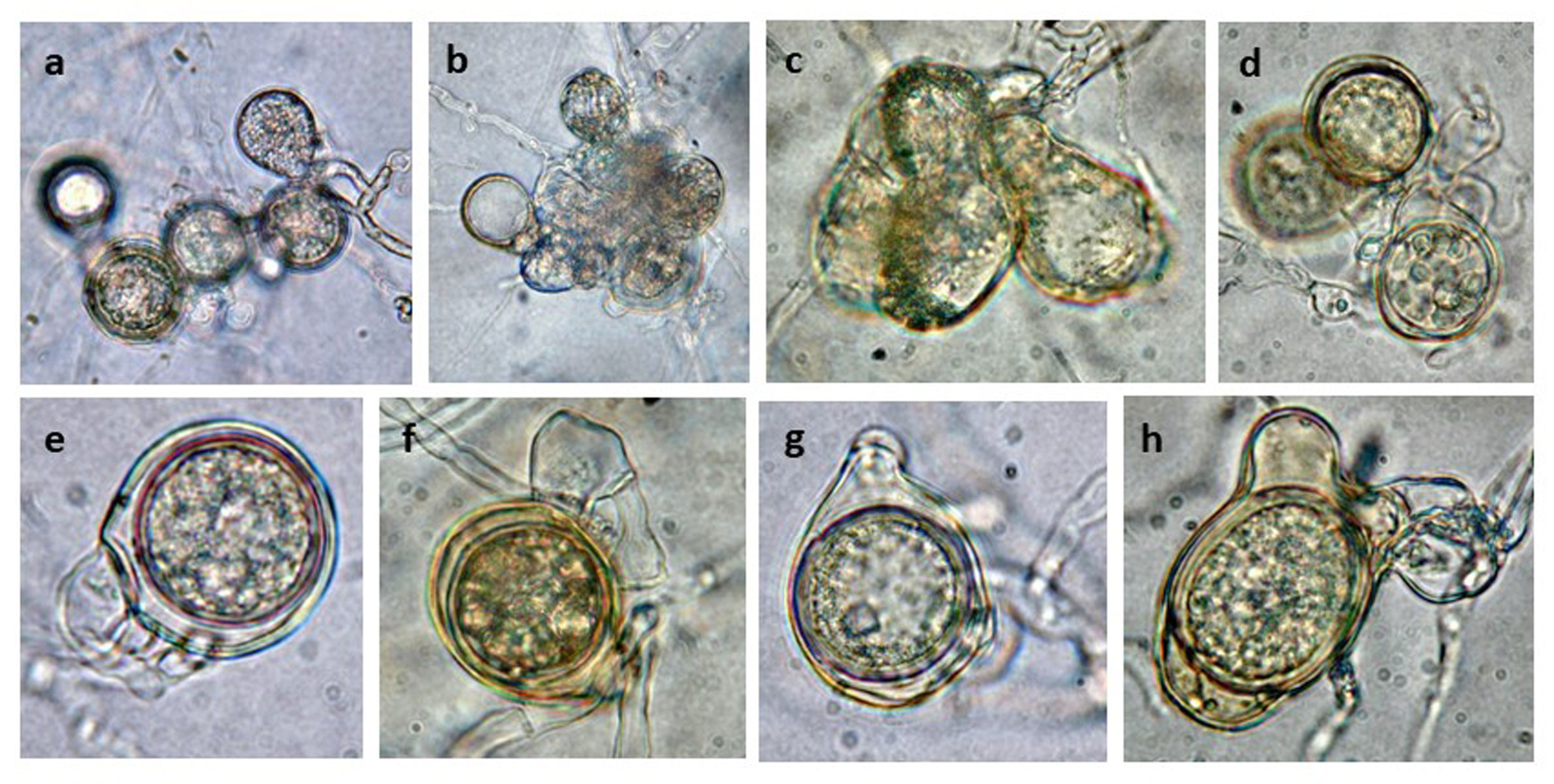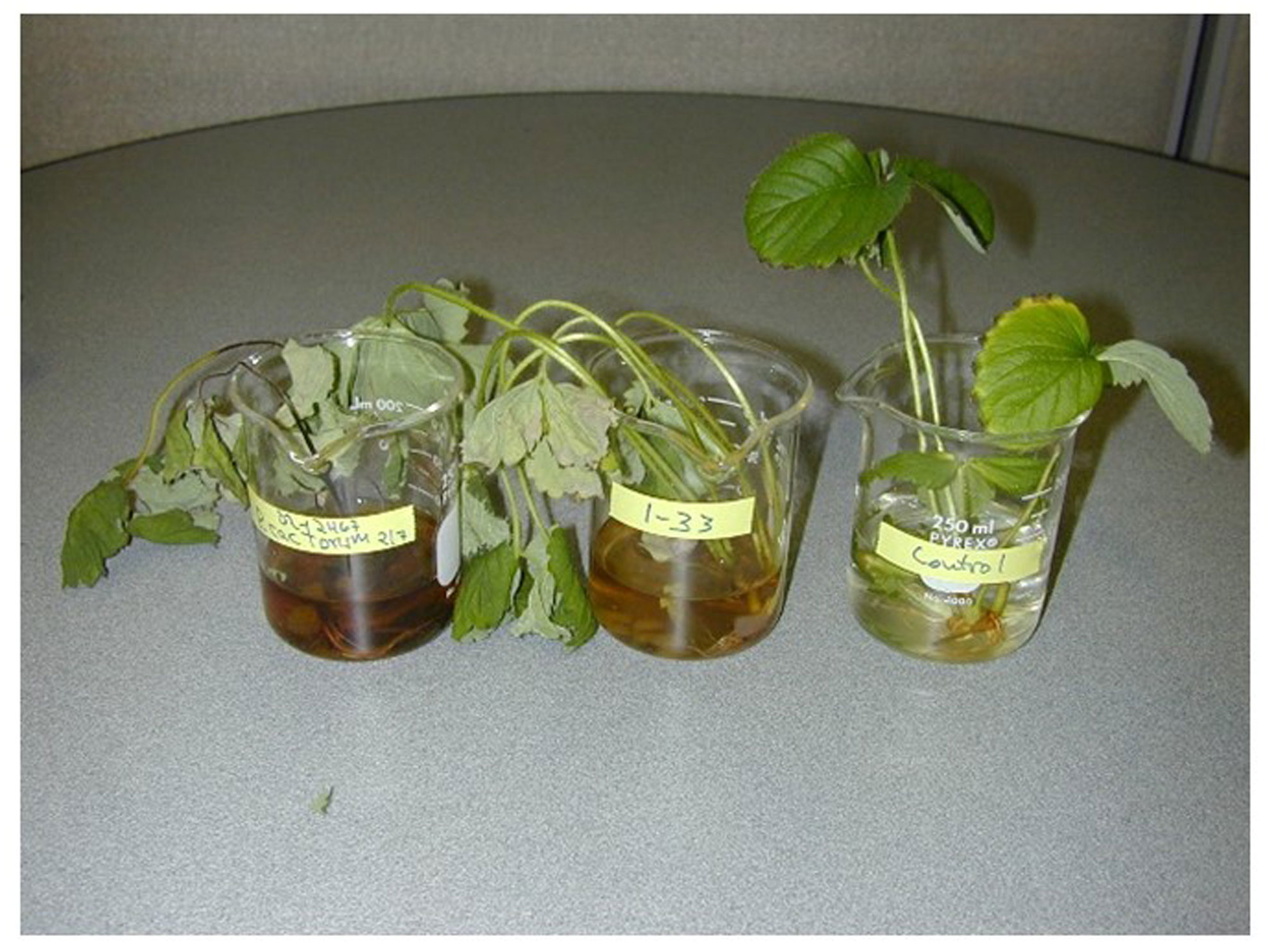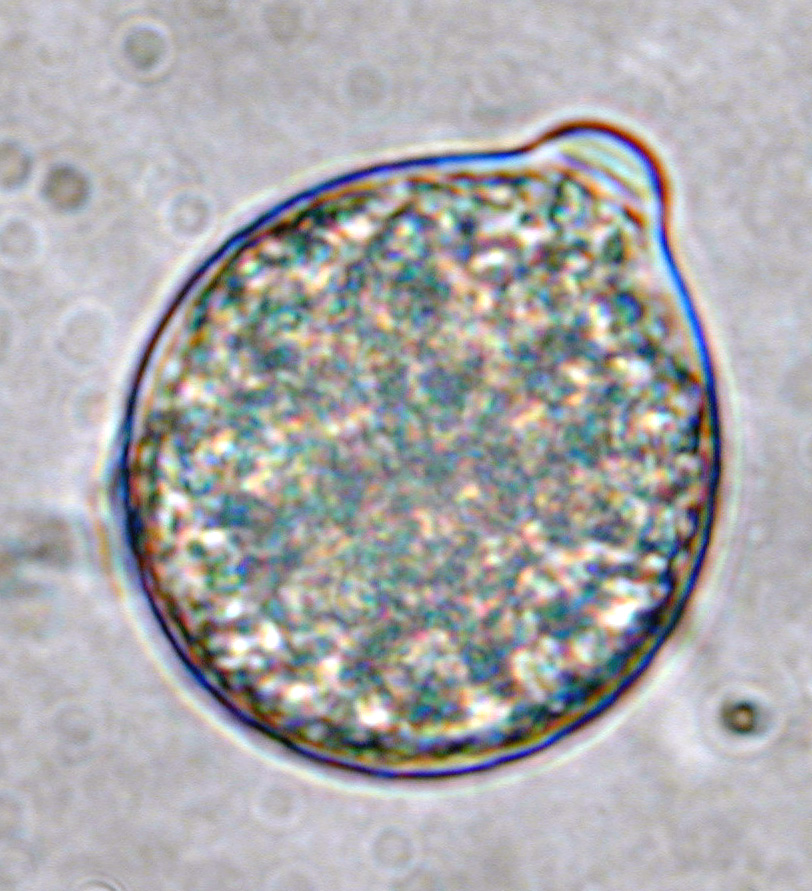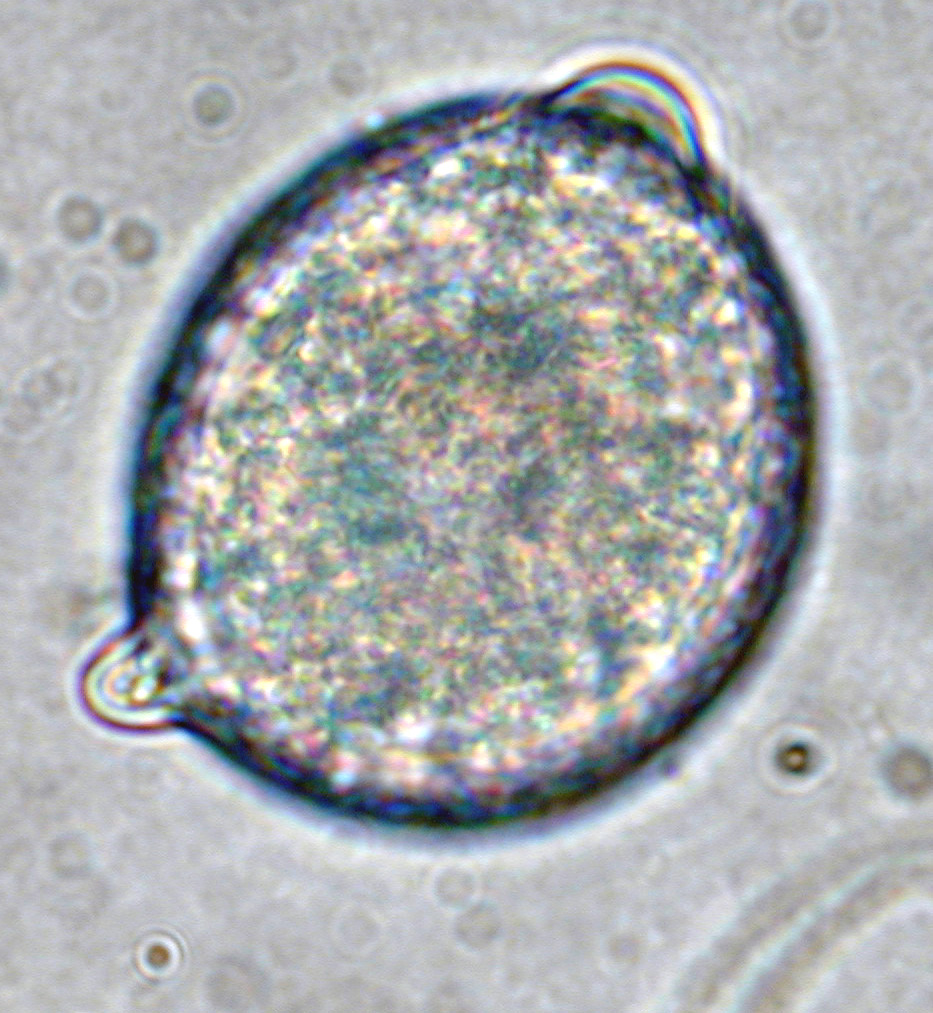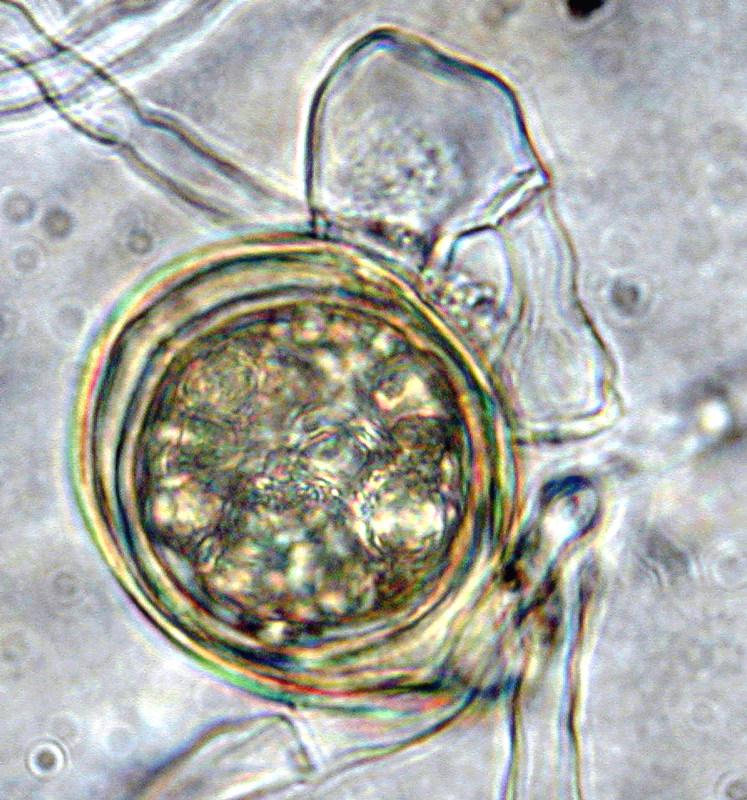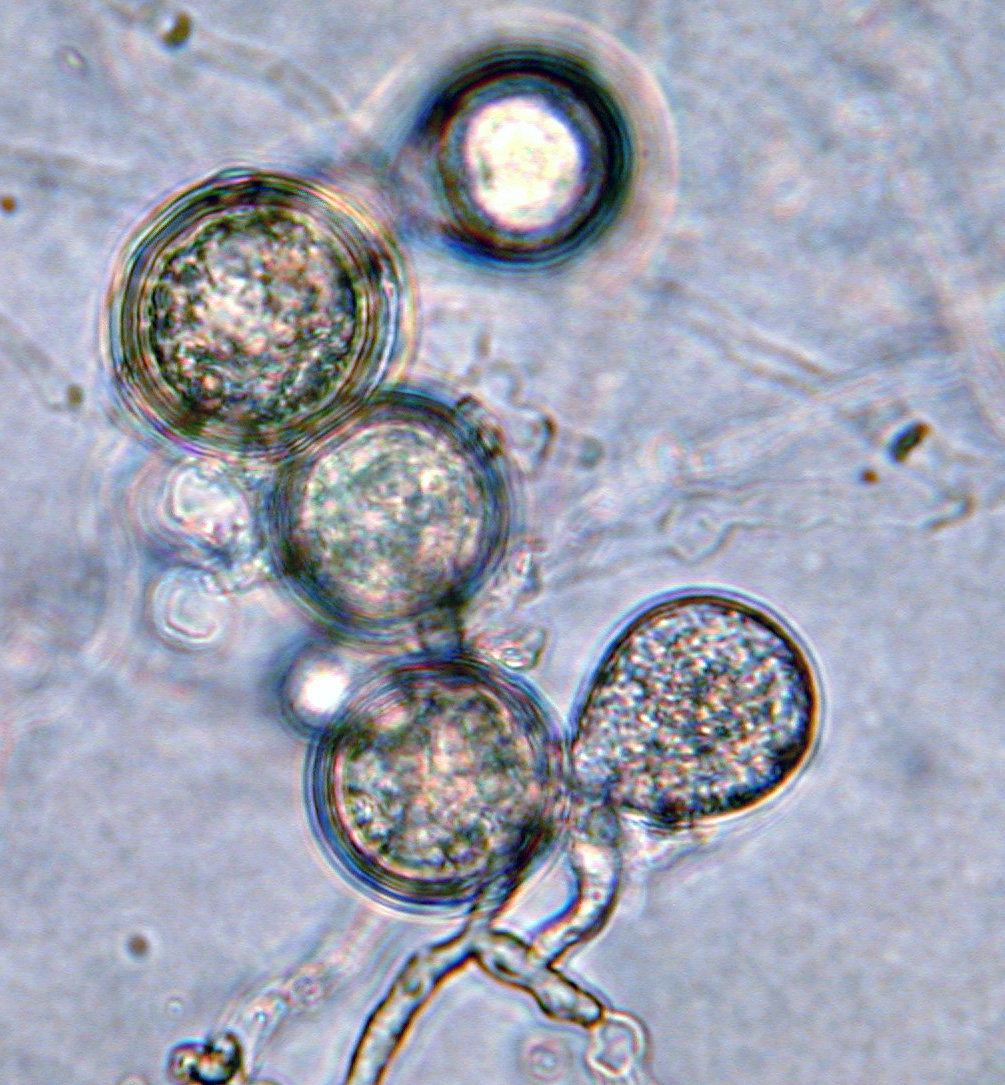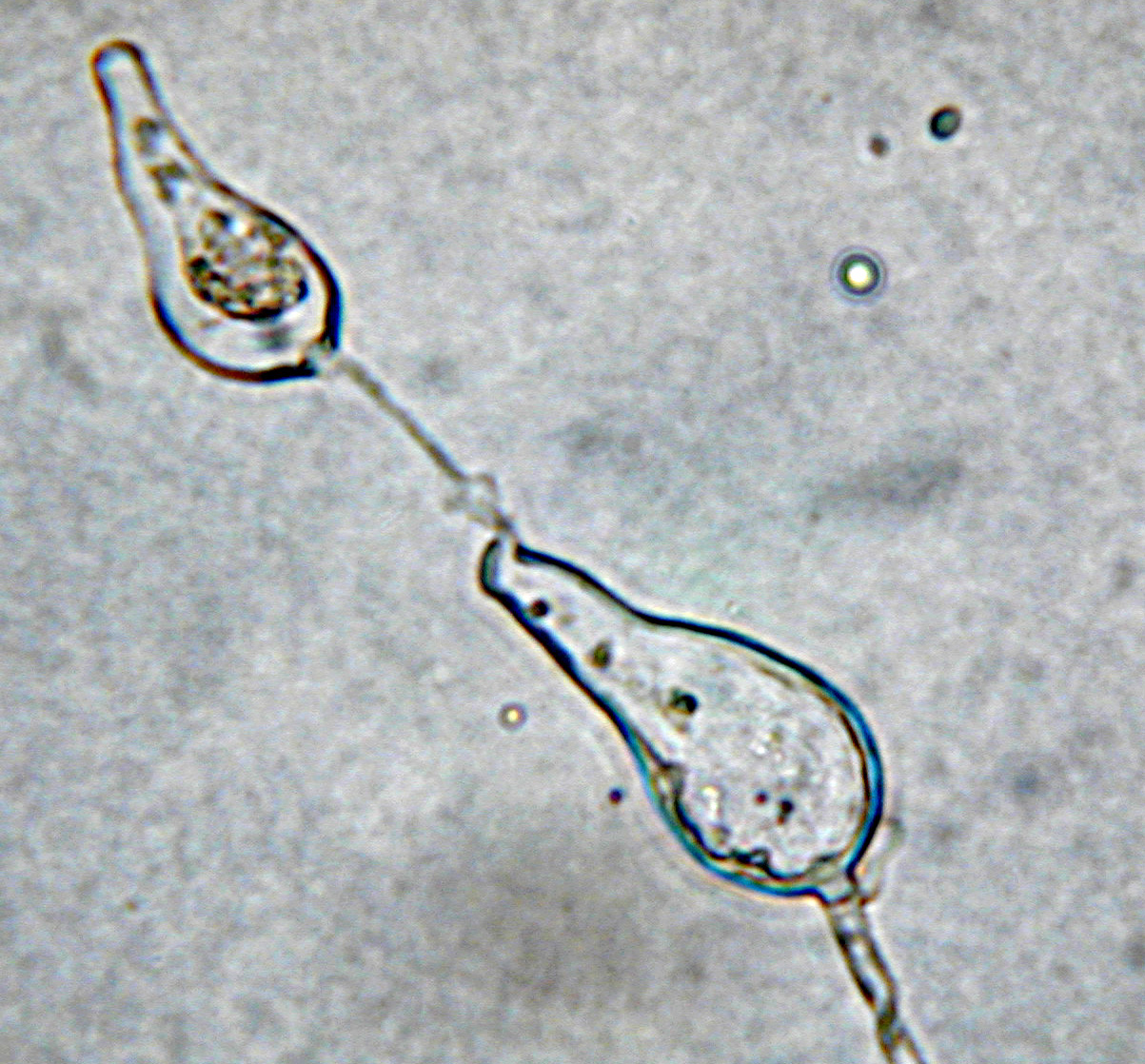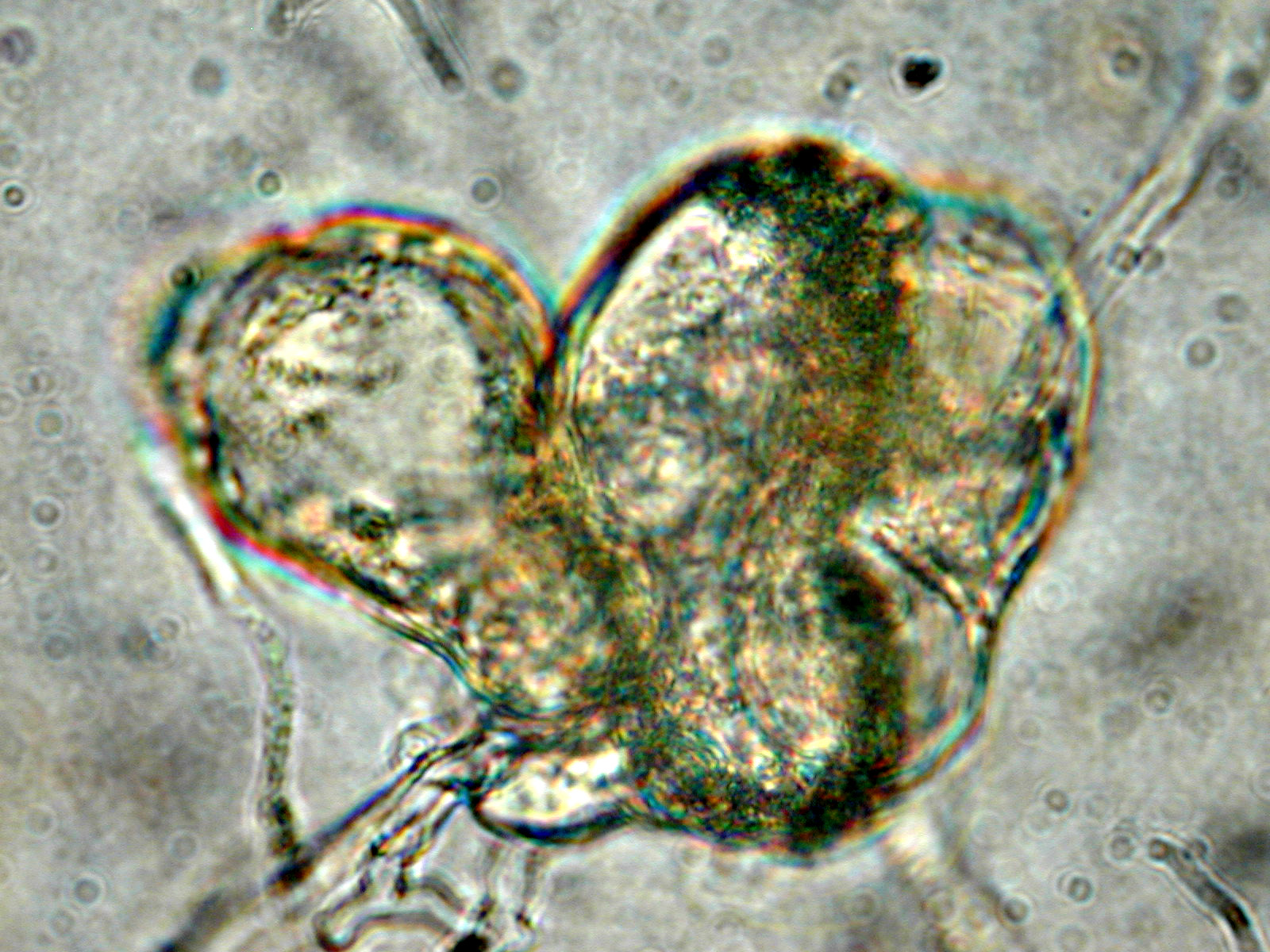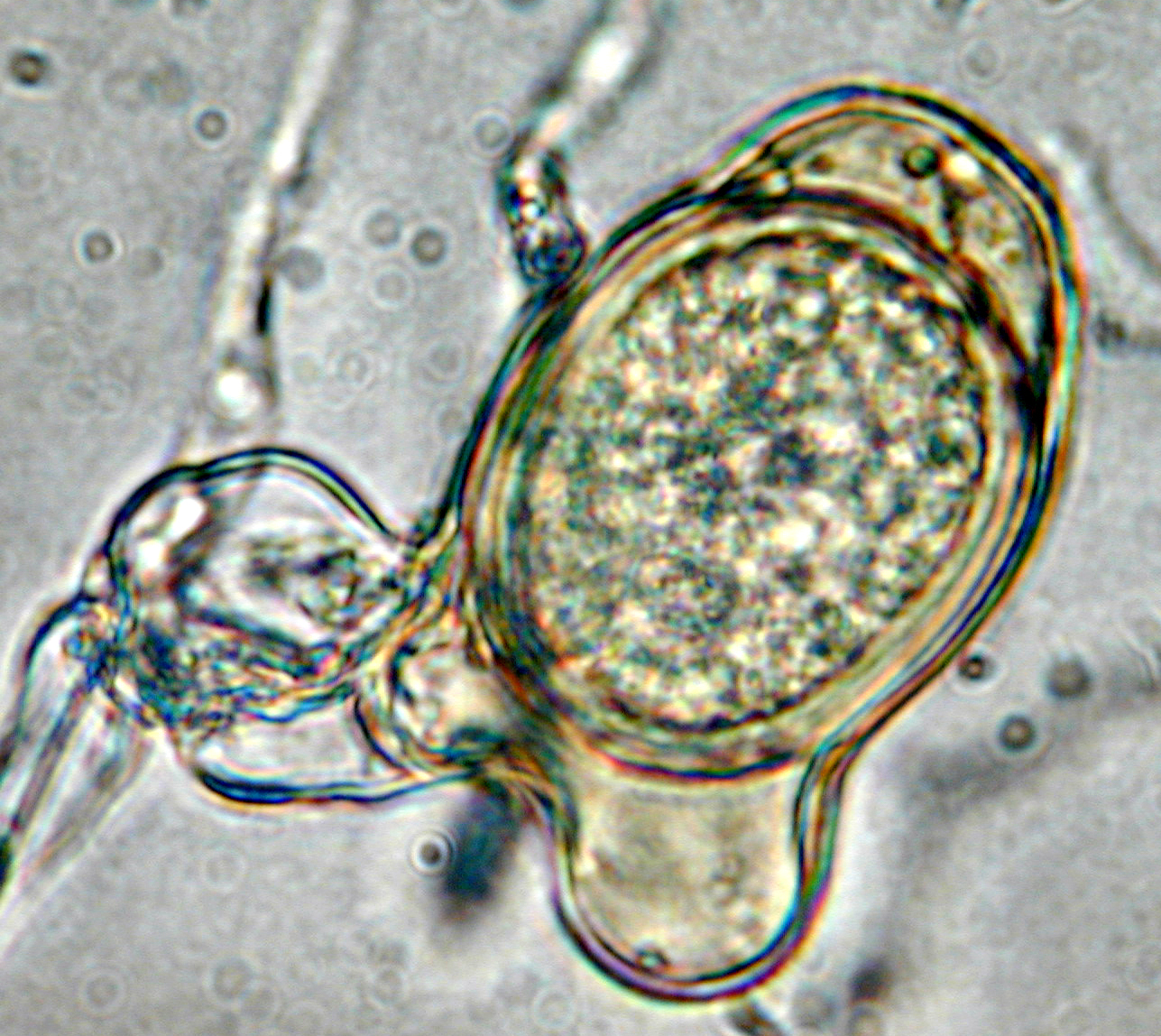Phytophthora bishii
|
Phytophthora spp. in Clade 2e: portion of the seven-loci ML phylogeny featuring the type cultures of 212 described species (by T. Bourret). Notice the position of P. bishii Ex-type CBS 122081 = S&T BL 6. Gloria Abad, USDA S&T.
|
|
Phytophthora spp. in Clade 2e: Morphological Tabular key (PDF) and Tabular key legends (PDF) in IDphy2 KEY SECTION. Notice the data of P. bishii Ex-type CBS 122081 = S&T BL 6. Gloria Abad, USDA S&T.
|
|
Phytophthora bishii (CPHST BL 6) colony of the ex-type grown for 7 days on (a) V8® Agar, (b) potato dextrose agar, and (c) malt extract agar; photo by Krysta Jennings and Leandra Knight, USDA-APHIS-PPQ |
|
Phytophthora bishii (CPHST BL 6) asexual phase of the ex-type: (a-i) semipapillate persistent sporangia with different shapes, originated in simple sympodial sporangiophore (a-c) and (d) by external proliferation; (j-m) hyphal swellings; photos by G. Abad, USDA-APHIS-PPQ. |
|
Phytophthora bishii (CPHST BL 6) sexual phase of the ex-type (a-h): photos by G. Abad, USDA-APHIS-PPQ. |
|
pathogenicity test of Phytophthora bishii (Abad 1-33) selected specimen (center) as compared with an isolate of P. cactorum (Abad Ph338) (left) and healthy control (right); photo by Gloria Abad at the former Plant Pathogen Identification Laboratory (PPIL), Department of Plant Pathology, North Carolina State University, USA (2001-2006) |
|
Phytophthora bishii (CPHST BL 6) asexual phase of the ex-type: hyphal swellings; photo by G. Abad, USDA-APHIS-PPQ. |
|
Phytophthora bishii (CPHST BL 6) sexual phase of the ex-type: oospore with paragynous antheridium; photo by G. Abad, USDA-APHIS-PPQ. |
|
Phytophthora bishii (CPHST BL 6) asexual phase of the ex-type: semipapillate persistent sporangium; photo by G. Abad, USDA-APHIS-PPQ. |
|
Phytophthora bishii (CPHST BL 6) asexual phase of the ex-type: bipapillate persistent sporangium; photo by G. Abad, USDA-APHIS-PPQ. |
|
Phytophthora bishii (CPHST BL 6) sexual phase of the ex-type: aplerotic oospore with paragynous antheridium; photo by G. Abad, USDA-APHIS-PPQ. |
|
Phytophthora bishii (CPHST BL 6) sexual phase of the ex-type: oospores with paragynous antheridia; photo by G. Abad, USDA-APHIS-PPQ. |
|
Phytophthora bishii (CPHST BL 6) sexual phase of the ex-type: oospores; photo by G. Abad, USDA-APHIS-PPQ. |
|
Phytophthora bishii (CPHST BL 6) sexual phase of the ex-type: oospores with paragynous antheridia; photo by G. Abad, USDA-APHIS-PPQ. |
|
Phytophthora bishii (CPHST BL 6) asexual phase of the ex-type: sporangia with external proliferation; photo by G. Abad, USDA-APHIS-PPQ. |
|
Phytophthora bishii (CPHST BL 6) sexual phase of the ex-type: oospores with paragynous antheridia; photo by G. Abad, USDA-APHIS-PPQ. |
|
Phytophthora bishii (CPHST BL 6) asexual phase of the ex-type: semipapillate persistent sporangium; photo by G. Abad, USDA-APHIS-PPQ. |
|
Phytophthora bishii (CPHST BL 6) asexual phase of the ex-type: semipapillate persistent sporangium; photo by G. Abad, USDA-APHIS-PPQ. |
|
Phytophthora bishii (CPHST BL 6) sexual phase of the ex-type: aplerotic oospore with paragynous antheridium; photo by G. Abad, USDA-APHIS-PPQ. |
|
Phytophthora bishii (CPHST BL 6) asexual phase of the ex-type: semipapillate persistent sporangium; photo by G. Abad, USDA-APHIS-PPQ. |
|
Phytophthora bishii (CPHST BL 6) asexual phase of the ex-type: semipapillate persistent sporangia borne on simple sympodial sporangiophore; photo by G. Abad, USDA-APHIS-PPQ. |
|
Phytophthora bishii (CPHST BL 6) asexual phase of the ex-type: semipapillate persistent sporangia borne on simple sympodial sporangiophore; photo by G. Abad, USDA-APHIS-PPQ. |
|
Phytophthora bishii (CPHST BL 6) asexual phase of the ex-type: hyphal swellings; photo by G. Abad, USDA-APHIS-PPQ. |
|
Phytophthora bishii (CPHST BL 6) asexual phase of the ex-type: semipapillate persistent sporangia borne on simple sympodial sporangiophore; photo by G. Abad, USDA-APHIS-PPQ. |
|
Phytophthora bishii (CPHST BL 6) asexual phase of the ex-type: hyphal swellings; photo by G. Abad, USDA-APHIS-PPQ. |
|
Phytophthora bishii (CPHST BL 6) asexual phase of the ex-type: hyphal swellings; photo by G. Abad, USDA-APHIS-PPQ. |
Name and publication
Phytophthora bishii Abad, J.A. Abad & Louws (2008))
Variant spelling Phytophthora bisheria Z.G. Abad, J.A. Abad & F.J. Louws 2008
Notes: The epithet of this name was corrected in accordance with Article 60 of the ICBN.
Abad ZG, Abad JA, Coffey MD, Oudemans PV, Man in ’t Veld WA, de Gruyter H, Cunnington J, and Louws FJ. 2008. Phytophthora bisheria sp. nov., a new species identified in isolates from the Rosaceous raspberry, rose, and strawberry in three continents. Mycologia 100: 99–110.
Corresponding author: Gloria.Abad@aphis.usda.gov
Nomenclature
from Abad et al. (2008)
Mycobank
Etymology
named in honor of Eric Bish (1967–2000), who was a strawberry specialist in the Dept. of Horticulture-NCSU and valued collaborator on the strawberry diseases project (Dept. of Plant Pathology-NCSU)
Typification
Type: UNITED STATES OF AMERICA, North Carolina, Raleigh, from roots of strawberry (Fragraria x ananassa) in greenhouse, 16 Nov 1999, collector Z.G. Abad, BPI 878369 in Herbarium (dried culture on baby carrot agar from isolate Cg 2.3.3)
Ex-type: CBS 122081
Sequences for ex-type in original manuscript: Phytophthora bisheria isolate Cg.2.3.3 = ITS rDNA: AY241924
Ex-type in other collections
(ET) CBS 122081, WPC P10117, Cg 2.3.3 (G. Abad), S&T BL 6 (Abad), 31E6 (Hong)
Molecular identification
Voucher sequences for barcoding genes (ITS rDNA and COI) of the ex-type (see Molecular protocols page)
Phytophthora bishii isolate CPHST BL 6 (= P10117 WPC) = ITS rDNA MG783381, COI MH136851
Selected specimen
Phytophthora bishii isolate 1-33 (Abad) = ITS rDNA AF408625
Voucher sequences for Molecular Toolbox with seven genes (ITS, β-tub, COI, EF1α, HSP90, L10, and YPT1
(see Molecular protocols page) (In Progress)
Voucher sequences for Metabarcoding High-throughput Sequencing (HTS) Technologies [Molecular Operational Taxonomic Unit (MOTU)]
(see Molecular protocols page) (In Progress)
Sequences with multiple genes for ex-type in other sources
- NCBI: Phytophthora bisheria CPHST BL 6
- NCBI: Phytophthora bisheria P10117
- NCBI: Phytophthora bishii CBS 122081
- EPPO-Q-bank: Phytophthora bisheria CBS 122081
- BOLDSYSTEMS: Phytophthora bisheria (barcoding COI & ITS)
Notes
- Phytophthora DATABASE: Phytophthora bisheria P10117 not available. Originally, PD had the extype Cg 2.3.3 WPC P10117 ITS FJ801281, TEF WPC P10117 PD-00066 EU080743, EU080742 WPC P10117 PD-00066, but this information has been removed (search on 7/12/13). Isolates P1620 (PD_00051) with different genes in PD and CBS 114090 = P1621 = Benson 412 with ITSrDNA and CoxI do not correspond to P. bisheria. They correspond to Phytophthora taxon pseudobisheria in progress by Z.G. Abad.
- EPPO-Q-bank: Phytophthora bisheria representative strain CBS 114090 = P1621 = Benson 412 (corresponds to P. taxon pseudobisheria G. Abad in progress). Other strain CBS 122081 is correct.
Position in multigenic phylogeny with 7 genes (ITS, β-tub, COI, EF1α, HSP90, L10, and YPT1)
Clade 2e
Morphological identification
Colonies and cardinal temperatures
Colonies on potato dextrose agar and malt extract agar with no distinct pattern, on V8 agar with slow growth. Minimum temperature for growth is 10°C, optimum 26°C, and maximum 32°C.
Conditions for growth and sporulation
Abundant oosporeoospore:
zygote or thick-walled spore that forms within the oogonium after fertilization by the antheridium; may be long-lived
production is observed on V8-A after 10 d culture in the dark. OogoniaOogonia:
the female gametangium in which the oospore forms after fertilization by the antheridium
are formed rarely in water cultures.
Asexual phase
Sporangia semipapillate, some bipapillate; persistentpersistent:
pertaining to sporangia that remain attached to the sporangiophore and do not separate or detach easily (cf. caducous)
; ovoidovoid:
egg-shaped, with the widest part at the base of the sporangium and the narrow part at the apex
, obpyriformobpyriform:
inversely pear-shaped, i.e. with the widest part at the point of attachment (cf. pyriform)
, ovoid-obpyriform, obturbinate, globoseglobose:
having a rounded form resembling that of a sphere
(23 µm diam), or irregular and usually have a tapered basetapered base:
pertaining to the base of a sporangium or oogonium; funnel-shaped
; a large vacuole is observed in many sporangia; sporangiasporangia:
sac within which zoospores form, especially when water is cooled to about 10°C below ambient temperature; in solid substrates, sporangia usually germinate by germ tubes
are originated by direct germination of primary sporangiasporangia:
sac within which zoospores form, especially when water is cooled to about 10°C below ambient temperature; in solid substrates, sporangia usually germinate by germ tubes
or individually in long unbranched sporangiophores. Sporangiophores may have hyphal swellings. Hyphal swellings sometimes present with coraloid nodose irregular shapes and hairy projections. ChlamydosporesChlamydospores:
an asexual spore with a thickened inner wall that is delimited from the mycelium by a septum; may be terminal or intercalary, and survives for long periods in soil
absent.
Sexual phase
Homothallic. OogoniaOogonia:
the female gametangium in which the oospore forms after fertilization by the antheridium
smooth-walled but sometimes producing irregular projections, spherical 24–46 (av. 35) µm diameter, terminal, rarely intercalaryintercalary:
positioned within a hypha (cf. terminal)
. Antheridia paragynous paragynous:
pertaining to the sexual stage in which the antheridium is attached to the side of the oogonium (cf. amphigynous)
with broad attachment to the oogonial wall 7–11 (av. 9.5) µm, frequently with long stalk and branched. Occasionally two or three antheridiaantheridia:
the male gametangium; a multinucleate, swollen hyphal tip affixed firmly to the wall of the female gametangium (the oogonium)
per oogoniumoogonium:
the female gametangium in which the oospore forms after fertilization by the antheridium
are observed. OosporesOospores:
zygote or thick-walled spore that forms within the oogonium after fertilization by the antheridium; may be long-lived
apleroticaplerotic:
pertaining to a mature oospore that does not fill the oogonium; i.e. there is room left between the oospore wall and oogonium wall (cf. plerotic)
, rarely pleroticplerotic:
pertaining to an oospore that fills the oogonium (cf. aplerotic)
, 25–31 (av. 28) µm diameter, wall 4–6 (av. 5) µm thick.
Most typical characters
Phytophthora bishii can be discriminated from other taxa on the basis of the structure of the antheridiaantheridia:
the male gametangium; a multinucleate, swollen hyphal tip affixed firmly to the wall of the female gametangium (the oogonium)
, oogoniaoogonia:
the female gametangium in which the oospore forms after fertilization by the antheridium
, and oosporesoospores:
zygote or thick-walled spore that forms within the oogonium after fertilization by the antheridium; may be long-lived
, and the production of typical broad attachment antheridiaantheridia:
the male gametangium; a multinucleate, swollen hyphal tip affixed firmly to the wall of the female gametangium (the oogonium)
.
Specimen(s) evaluated
Phytophthora bishii CPHST BL 6 (Abad) = P10117 [World Phytophthora Collection (WPC) California, USA] duplicate of the ex-type CBS 122081
Hosts and distribution
Distribution: North Carolina, USA; Netherlands; Knoxfield, Australia
Substrate: roots of strawberry, roots of young rose cuttings, roots of raspberry
Disease note: Symptoms include slight yellowing and root rot. Infected cuttings are stunted, have fewer side shoots, and smaller dull green leaves that yellow and shed prematurely. Newly formed roots are rotted.
Hosts: Phytophthora bisheria has been recovered from Fragaria X ananassa (strawberry) roots in North Carolina, USA, rose in the Netherlands, and Rubus idaeus (raspberry) in Australia.
Retrieved January 19, 2018 from U.S. National Fungus Collections Nomenclature Database.
Additional references and links
- SMML USDA-ARS: Phytophthora bishii
- EPPO Global Database: Phytophthora bishii
- Forest Phytophthoras of the world: Phytophthora bishii
- CABI Digital Library: Phytophthora bishii
- Encyclopedia of Life (EOL): Phytophthora bisheria
- Index Fungorum (IF): Phytophthora bishii
- Google All Phytophthora bishii
- Google Images Phytophthora bishii
- Google Scholar Phytophthora bishii
- Google All Phytophthora bisheria
- Google Images Phytophthora bisheria
- Google Scholar Phytophthora bisheria
Fact sheet author
Z. Gloria Abad, Ph.D., USDA-APHIS-PPQ-S&T Plant Pathogen Confirmatory Diagnostics Laboratory (PPCDL), United States of America.


